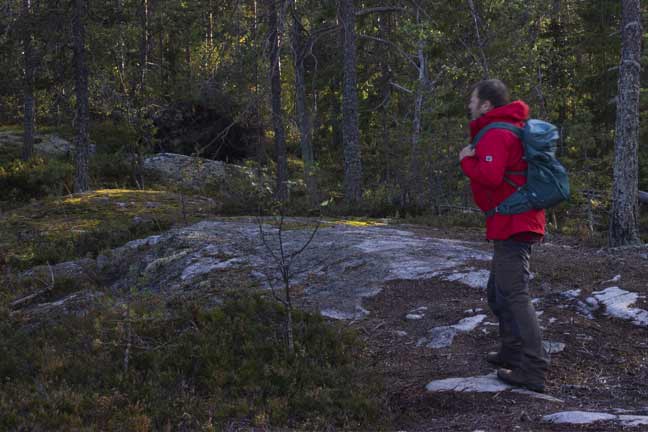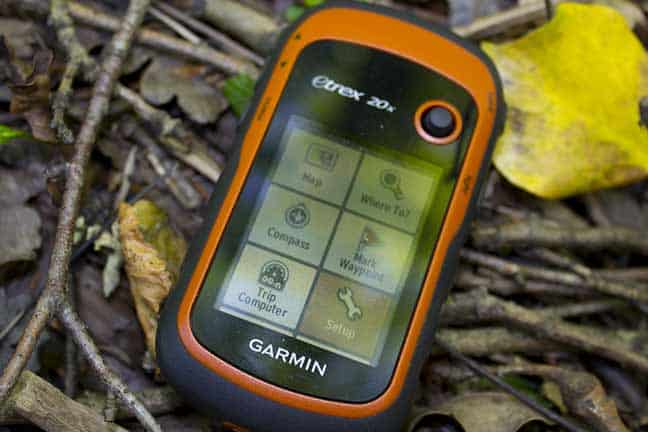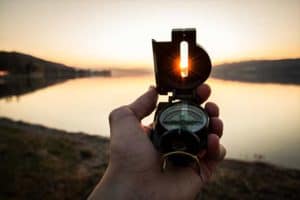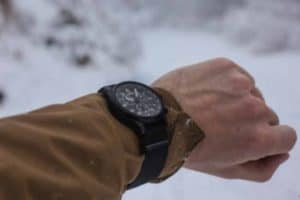This page may have Commerce Content. If you buy something from our posts, we may get a small share of the sale. Click here for more.


Editor & Article Writer for Outdoor Wilds
As an Amazon Associate I earn from qualifying purchases. Thank you for helping to support the site.
Best Backpacking GPS Reviews
An accurate feature-packed backpacking GPS is essential to anyone who spends a great deal of time outdoors. Whether you are hiking, adventuring, hunting, or exploring a handheld GPS will allow you to navigate difficult terrain with ease.
Most good devices feature mapping software such as Garmin Basecamp which allows you to mark out your journey prior to leaving and keep track of your trail as you progress.
The ability to make notes concerning each waypoint soon becomes a familiar go-to, helping you to keep detailed information concerning the areas which you have explored.
The best handheld GPS devices will point out key points-of-interest including streams, landmarks, notable areas and trails, and even where you parked your vehicle. There is no getting lost and no forgetting any details of the adventure.
When shopping for the best backpacking GPS one is bombarded with options. Yet, only a few devices manage to excel at almost all attributes, as is needed when in a harsh environment.
A good handheld GPS needs to not only be accurate and intuitively designed but also exhibit outstanding battery life, multiple sensors, the ability to connect to numerous GPS satellite networks, and at the same time remain affordable.
Here’s a detailed look at the five best backpacking GPS devices available, giving you the perfect option for your needs and budget.
Popular Posts
Last update on 2024-04-07 / Affiliate links / Images from Amazon Product Advertising API
The Garmin 750T is a feature-rich backpacking GPS which exhibits outstanding build-quality and versatile functionality.
Despite the slightly steep learning curve, this is a handheld GPS which delivers everything that the avid hiker needs to track their journey.
From a 3-inch touch-screen readable in bright sunlight, to sensors for everything you may need, IPX7 water-resistance, and a built-in 8-megapixel autofocus camera, the Garmin 750T won’t disappoint. Here’s a closer look.
Garmin have redesigned the antenna of the Oregon 750T, giving it accurate GPS and GLONASS satellite tracking in even the most challenging conditions.
The unit even gives you active weather forecasts when the feature has been activated, as well as animated map overlays, a 3-axis compass, and a barometric altimeter.
Geocache information is downloaded automatically, and the device keeps track of your journey through smart notifications.
The Garmin connect online community lets you add notes to LiveTrack location data and geocache discoveries, updating either the entire community, or syncing with any of your other devices individually.
It runs on 2 AA Lithium batteries, or a rechargeable Ni-MH pack. A huge number of waypoints can be stored although the user interface could be easier to operate.
Pros
- 3-Axis Tilt-Compensated Compass
- Accelerometer & Barometric Altimeter
- IPX7 Waterproof
- Integrated 8-Megapixel Camera
- Enhanced Wireless Connectivity (Wi-Fi, Bluetooth, ANT+)
Cons
- City Maps Require Additional Purchase
- Accuracy Issues with Battery Readout
Summary
Overall, the Garmin 720T is an accurate backpacking GPS with the support to connect to multiple satellites as a failover.
It’s great for any type of terrain and is both small and lightweight enough to never get in the way. Auto-navigation has been criticized for having slight tracking bugs in an urban setting, but once out on the trail you’ll love the features of this top-end handheld GPS.
Last update on 2024-04-27 / Affiliate links / Images from Amazon Product Advertising API
The Garmin 680T easily offers the best value for money and performance out of the entire range reviewed. While one of the older models from Garmin’s range, this is still an outstanding backpacking GPS which is packed with features.
Many praise its ease-of-use over other models, whilst its technical capabilities and practical functions are invaluable to anyone who loves the outdoors. Here’s a closer look at this great handheld GPS.
As a WAAS-enabled GPS receiver, the Garmin Montana 680T exhibits high-sensitivity GPS and GLONASS tracking in any conditions. It finds your position quickly and maintains its accuracy even in the deepest of canyons.
A sunlight readable 4-inch touch screen gives you access to the highly intuitive software making the 680T one of the easiest-to-use Garmin’s around.
An 8-mega-pixel camera with autofocus is integrated, and all your pictures are fully geotagged.
The track log of the Garmin Montana 680T can handle 10,000 points, 200 saved tracks, and 4000 waypoints. Lithium-ion batteries give you around 16 hours of battery life, while if you fit AA batteries instead the GPS is rated at 22-hours.
Each unit even comes with a 1-year Birdseye Satellite Imagery subscription and 250,000 preloaded geocaches, while also having its own 3-axis compass with barometric altimeter.
Pros
- 250,000 Preloaded Geocaches
- One Year Birdseye Satellite Imagery Subscription
- WAAS Enabled GPS & GLONASS
- Integrated 8-Megapixel Camera
- 4-Inch Touchscreen
Cons
- Altimeter Could Be More Accurate
- City Navigator Requires Separate Purchase
Summary
Waterproof, lightning quick to track your location, and fully supportive of the Garmin connect community for tracking and sharing your adventures, the Garmin 680T is a wonderful GPS to use.
It is an outstanding backpacking GPS, while working equally well as in-car device.
You don’t get lifetime updates and the city navigator will need to be bought separately, but the Garmin 680T is easily the best backpacking GPS for most casual hikers.
Last update on 2024-04-27 / Affiliate links / Images from Amazon Product Advertising API
Easy to read, highly sensitive, IPX-7 waterproof, and featuring goof value-for-money, the Magellan eXplorist 710 is one of the best backpacking GPS units around.
It carries its quirks and has an interface which could be easier to operate, however, these are minor caveats considering its low price and feature set. Let us take you through a look at the highs and lows of this trusty handheld GPS.
Thanks to being based on SiRFstarIII technology, the receiver benefits from solid construction. The receiver locks on quickly both indoors and under tree cover / within canyons.
You are supplied with 8 GB of onboard storage with the option of adding an additional SD card, while the camera is a 3.2 mega-pixel with autofocus taking shots up to 1600 x 1200 pixels. Video is supported, but only at a poor 320 x 240.
The mapping information is extremely detailed, with even the preloaded trail maps being quite accurate.
Visibility in the sunlight could be better, and the battery life itself is not all the good. A single set of AA rechargeable batteries give roughly six hours of use. Please note that despite the unit being compatible with rechargeable batteries, the handheld GPS itself can’t charge them. This is at times confused.
Pros
- 3-Axis Electronic Compass
- Barometric Altimeter
- IPX-7 Waterproof
- Decent 16-Hour Battery Life
- Dedicated Geocaching
Cons
- 3.2 Megapixel Camera Only
- Difficult Interface
- Requires Large Update
Summary
The Magellan eXplorist 710 may have a lot of features but most of them are tricky or buggy. This being said, you do get a backpacking GPS which works well in an urban setting at a fairly low price.
Its 3-axis electronic compass & barometric altimeter work as would be expected, while the device comes standard with City Series USA turn-by-turn navigation, and Summit Series USA topographic mapping.
Last update on 2024-04-27 / Affiliate links / Images from Amazon Product Advertising API
A satellite communicator makes for a great alternative to a standard backpacking GPS. The InReach Explorer exhibits outstanding global SOS functionality, accurate built-in navigation with notes, logs and waypoints, text messaging, and even pairing to mobile devices.
The only draw-back to these great practical benefits is the monthly cost of a DeLorme subscription.
Here we’ll take you through a closer look at what is being offered with this technically impressive device.
Even the Bluetooth pairing is better than normally, working perfectly to pair your device between a mobile phone at up to fifty feet away.
The device can update your Facebook and Twitter with journey updates and notes, and the battery life is nothing short of amazing. The InReach Explorer has everything that the outdoor enthusiast needs to stay safe, but given the subscription nature of the device, this is a purchase for dedicated users only.
Two-way conversation during a crisis will not only supply you with the information that you need to survive, but also the peace of mind that you need to pull it together.
Various tracking options are available at scaling costs, with packages available to track your location and well-being via satellite at ten-minute intervals. This is both an emergency device and communication tool among the best out there.
Pros
- Digital Compass, Barometric Altimeter & Accelerometer
- Supremely Accurate Real-Time Global Satellite Coverage
- Text Messaging via GPS
- Fantastic Emergency Functionality
- Personal SOS Tracking
Cons
- High Cost
- Subscription Based Service
Summary
If you know that you put your life in danger during hikes, sport, exploration, or any other treacherous outdoor activity, then this may be the best backpacking GPS for you.
Its functionality as an emergency device is invaluable but many may not need the security of a dedicated SOS team watching over their shoulder.
Last update on 2024-04-07 / Affiliate links / Images from Amazon Product Advertising API
The Garmin eTrex 10 Worldwide GPS Navigator is a WAAS-enabled GPS receiver featuring both HotFix and GLONASS support. Thanks to multiple satellite sources and a fast signal processing unit, you are guaranteed both accuracy and speed, while the unit itself is sturdy enough for the most rugged outdoor use.
Paperless geotagging, waypoint tracking with time estimates & distance, and BaseCamp 2D / 3D topographic map data make the Garmin eTrex 10 easily the best backpacking GPS available. Let’s see why.
Waypoint tracking is automatic on the eTrex 10, with both joystick and button-based navigation on offer. You are given an extremely rugged device which will withstand the hardest drops and knocks. It is best used as a handheld, backpacking GPS as no turn-by-turn is featured.
Track recording is fantastic and interacting with the interface is quite intuitive. It tracks elevation, rest time, and other metrics rather accurately, whilst the features do need to be learned manually. No manual is provided.
One can only assume that certain drawbacks such as the 2.2-inch monochrome display and the inability to load more detailed maps have resulted in the fantastic battery life.
The Garmin eTrex 10 gives you no less than 22-hours off just 2 AA batteries. No recharging is featured and the only connectivity is via USB. This being said, the device is easy to read in any lighting conditions, and the software could not be easier to use.
Pros
- WAAS Enabled with Hotfix & GLONASS
- Waypoint Tracking with High & Low Altitude Waypoints
- Dedicated Geocaching
- 20-Hour Battery Life
- Long-Lasting Weatherproof Durability
- IPX-7 Waterproof
Cons
- No Buzzer / Audible Alarm Sound
- Monochrome Display
- No Maps
Summary
The Garmin eTrex 10 Worldwide GPS Navigator performs admirably in any environmental conditions. It is a great device for those looking for an affordable, frills-free solution.
It may take some getting used to but once you’re familiar with the device you easily have the best backpacking GPS in terms of value-for-money.
The tracking is outstanding other than slight variations in your pattern of movement and the device is well-manufactured.
Last update on 2024-04-27 / Affiliate links / Images from Amazon Product Advertising API
Handheld GPS for Backpacking Buying Guide

If you are constricted by a budget or are looking for a no-frills device with great tracking functionality but no maps, then the Garmin eTrex 10 is a good choice.
You don’t get any added extras, but you can’t fault its value for money nor its performance and accuracy as a standalone backpacking GPS. However, if you want the best backpacking GPS available then the clear winner is the Garmin 680T.
Its large screen, 4GB of internal memory, high accuracy, broad reception, and easy-to-use interface coupled with a good battery life and the ability to store over 4000 waypoints make the Garmin 680T the very best backpacking GPS around.
A handheld global position system is an essential tool for anyone who enjoys hiking, hunting, camping, or any other form of outdoor adventuring.
Handheld satellite-based navigation work accurately and perfectly in any weather conditions, anywhere in the world. The best backpacking GPS receivers will report accuracy to within thirty feet, while those featuring WAAS (Wide Area Augmentation System) enhancements will be accurate to within ten feet.
Some even feature GLONASS satellite tracking as well as GPS-based navigation, as GLONASS is more accurate at high altitudes.
Here we’ll be showing you exactly why a backpacking GPS is an essential part of your gear, highlighting where it will benefit you, and how to make sure you get one which is suited to your needs.
Why Every Backpacker Needs a Handheld GPS
A handheld GPS is far more rugged than a GPS enabled smartphone or tablet with a GPS navigation and tracking app. The detail of data provided by a GPS is also far more informative than the basic info supplied by most apps.
Dedicated backpacking GPS units have far better satellite reception, whilst being able to lock-on to multiple GPS & GLONASS sources as well.
The battery life of a good handheld GPS gives you ample time to receive help in an emergency situation, whilst some come with satellite phone connectivity and fail-safe configurations in-case of the device failing completely.
You should always carry a map, paper, writing device, and compass as a backup to any GPS. Regardless of the quality of your gear, a manual backup is critical.
It’s also a good idea to bring backup batteries anytime you head out. Any good backpacking GPS will have mapping software which is frequently updated.
Make sure that you update your device often, before every trip would be a good idea. Most reliable software will give you the ability to track hundreds of waypoints and routes, whilst updating your map data with geocaching data for those who love the backcountry hunt.
Let’s take a closer look at what features you can expect from the best backpacking GPS receivers available.
Keep these factors in mind and you are assured a purchase which is not only good value for money, but a handheld GPS which can do everything that you need it do.
Essential Handheld GPS Functions
Every handheld GPS will give you real-time location tracking with distances, waypoints, and on-screen mapping.
Always observe the following features of each function to make certain that you have a GPS which is both a high quality and suited to your purpose.
GPS Positioning Information
A good handheld GPS will feature not only standard GPS tracking relative to your position, but also be capable of locking onto multiple GPS satellite sources.
Be on the lookout for devices which are WAAS (Wide Area Augmentation System) enabled, as they are accurate to within ten feet, whilst GLONASS enabled devices exhibit the highest accuracy at high altitudes.
Detailed On-Screen Mapping
Always check the accuracy of the map scale, and the tracking of the device. Ensure that your mapping software receives regular updates, and perhaps see whether or not city mapping is available for your device. It is quite useful for those who do not have in-car navigation present.
Also make sure that the on-screen map is user-friendly or else your device will become a pain to use.
Another factor to compare is the number of routes and waypoints which your handheld GPS can track. Certain models supply vastly improved capacity over others with point-of-interest and map updates from official online communities.
Extended Battery Life Essential
The best hand GPS receivers will feature outstanding battery life, with the ability to charge the batteries whilst plugged into the device itself. Not all units feature this function, although any good GPS should be capable of using Lithium and Ni-MH rechargeable.
Top models will give around two weeks when functioning as a sensor, updating map data. Most mid-range handheld GPS units will start at roughly twenty-five hours on a set of two to four AA batteries.
Long-Lasting Weatherproof Durability
Any good handheld GPS designed for backpacking will exhibit solid construction and good general weather-resistance. Be on the lookout for an official waterproof rating such as an IPX7 water-resistance certification as it guarantees that your device can withstand submersion up to depths of one meter, or three feet, for up to one minute. The higher the rating the better.
Enough Storage Capacity
Your device should feature a decent amount of onboard storage with the ability to have this upgraded through the addition of an addition SD card. Most good devices support up to 512GB of SD storage, while featuring an onboard capacity ranging from 2GB upward on a high-end handheld GPS.
Compass & Sensors
Entry level handheld GPS units typically use a traditional compass, whilst better models utilize an electric 3-axis compass and usually have a barometric altimeter as well. Pay attention to the sensors present on your device and be on the lookout for handy features such as an accelerometer, satellite text messaging, and wireless data sharing.
Integrated Camera with Geotagging
While not every device has a camera, some have a mediocre quality camera for basic image capturing. If your handheld GPS does have a camera, then it is essential for the camera to geotag all photographs. Make sure geotagging is supplied.
Enhanced Connectivity Options
Some good handheld GPS devices will allow you to synchronize data wirelessly with a tablet, desktop computer, or mobile device. Communities such as Garmin connect allow users to share trip data, receiving map and location updates from an extensive online community.
Built-in Connectivity
Built-in connectivity options should feature a cabled USB connection at a minimum, whilst Bluetooth is always welcomed, and Wi-Fi is available on higher-tier handheld GPS devices.
Screen Size & Quality
Most users prefer a weatherproof touch-screen over a conventional display and buttons. Make sure your touch screen works easily with gloves on, while if your screen is sacrificed for battery life, try out the menu to judge whether the interface is workable whilst outdoors, possibly in taxing conditions. It must be intuitive.
Weight & Portability
Whether this is a major factor or not will depend on your personal preferences, however, keep in mind that if you use the GPS during adventure sports, day hikes, or any other short excursion, you’ll want something which is highly portable and lightweight.
Availability of Accessories
Most leading handheld GPS units for backpacking and other outdoor use will have a range of accessories available as well. Be on the lookout for car charges, storage cases, battery-upgrades, belt and backpack clips. Thanks to being specifically designed for the device, these accessories often become invaluable.














